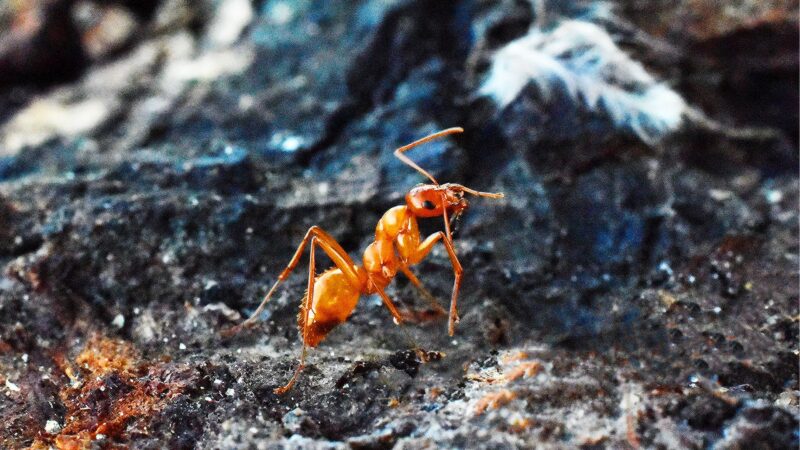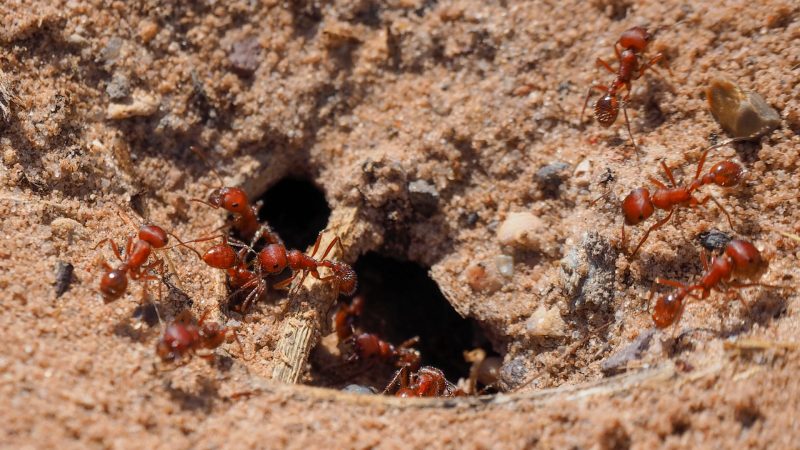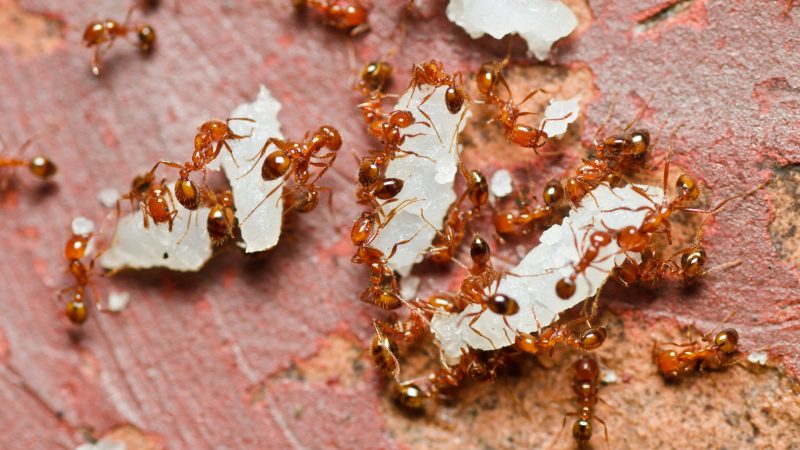Fire ants are mostly known in the southern parts of the USA, and everyone that comes in contact with them remembers their painful sting forever. These ants have one of the most powerful stings in the ant world and can also cause an allergic reaction, so if you find them on your property, eliminate them immediately.
What Are Fire Ants?

Fire ants (Solenopsis Invicta) are also called red, ginger, and tropical fire ants, and the name fire ant comes from their red body and very painful sting. We also call them the red imported fire ants, who came to the USA around 1930 from South America.
How to Identify Fire Ants?
Red fire ants are reddish-brown everywhere except on their abdomen, which is transparent and brownish-black. Black fire ants are totally black with no other color differences.
When compared to other varieties of ants, both are quite little, ranging from 0.05 to 0.2 inches in length. Within a single colony, fire ant sizes vary.
Where Do Fire Ants Live?

Fire ants build nests in moist soil near rivers, ponds, and regularly watered lawns. Their nests are hard to find because they are built beneath fallen trees, logs, bricks, or rocks. If they don’t have a spot to hide their nest, they build it in an open space in the shape of a dome with a height of up to 40 centimeters (15.748 in).
Fire ants are an aggressive and intrusive species, so in most cases, other similar species will just move away from their habitat. They are not keen on the company and prone to attack others. Then they direct their attack to the abdomen when they bite the target just to get a grip on them, and then they use their sting to inject the poison.
Fire Ant Queens
There are cases of multiple queens per fire ant colony, but mostly there is only one queen. Their reproduction rate is high, so they can enlarge their colony quickly. One fire ant queen can lay up to 1.500 eggs per day, and one colony can raise to 250.000 ants.
Fire Ant Lifespan
The life span of a fire ant is not that long compared to other species of ants. Fire ant queens live up to 6 years. Male ants die a couple of days after mating, and worker ants’ lifespan can vary from a couple of weeks to one month.
Types of Fire Ants
Red Imported Fire Ant
Homeowners claim that these ants are highly aggressive. They can build massive colonies with over 100.000 ants in mounds buried deep in the ground.
Black Fire Ants
The only difference between black and red fire ants is in their color. Black fire ants can also be either black or dark brown.
• Fire Ants With Wings
Fire ants have wings only in the same cases as other ants, which is when they are mating. Don’t confuse them for a separate species of ants as they are still fire ants.
Related: How Many Types of Ants Are There: Ant Identification Chart
Fire Ants vs. Red Ants: What’s the Difference?
Red ants can grow to be up to half an inch long, are often bigger than fire ants, and are also considerably less aggressive. Red ants do not swarm, thus an entire colony won’t rush to attack a single animal or pet. However, they can and will bite if they feel threatened. Fire ants do swarm, and numerous fire ants may swarm a victim before biting at once.
However, red ants typically build their nests in trees and other places where there is wood, as in wood heaps or even in sheds and houses. When fire ants are in their nests at night, red ants tend to be active.
Are Fire Ants Dangerous?
There is a common misconception that these ants bite with their claws, but the truth is, they use stings and not claws to attack. Their sting is one of the most painful in the ant world, and their venom can cause health problems if a person is allergic to it.
Is it possible for a fire ant to kill a human? There are documented cases, but those are very rare, and it is highly unlikely for a healthy person to die of their venom. Most of the people who died from it are those with already fragile health or in cases when multiple fire ants sting them.
Fire Ant Bite
Fire ant bite starts with intense pinching or burning pain right after you get bitten. A blister easily identifies the spot of a sting. The spot continues to burn and itch in the first couple of days after the sting.
They regularly attack in groups, so don’t be surprised if you notice several blisters in the same area. Remember, don’t try to pop them because they are only an allergic reaction to the ant venom, which can cause infections and scarring. The itching can last for weeks, so using ointment is necessary.
Symptoms
In most cases, fire ant stings will heal without treatment. Those with severe allergic reactions will feel the symptoms right after the sting. The common symptoms are:
- Having trouble with breathing
- Feeling of confusion
- Dizziness
- Nausea
- Swelling of the throat and tongue
- In some cases, loss of consciousness
Bite Treatment
Several remedies can help with itching and swelling. The most common and effective remedies are:
- Pressing the ice on the irritated area. This will reduce the swelling and ease the itching.
- Using hydrocortisone cream to relieve the itching.
- Antihistamine is a proven remedy for milder cases of allergic reactions.
- Triple antibiotic treatment helps when the blisters are scratched or infected and will prevent further infection (it is necessary to consult with the doctor if you have an infection on your body).
Should You Pop a Fire Ant Bite?
Never pop a fire ant bite blister because an exposed wound can cause an infection. Try to resist the urge to pop it, because any infection can become a serious problem.
How Long Do Fire Ant Bites Last?
How long the fire ant bites will last depends on the person, but on average, it takes 4 to 9 days for the symptoms to go away completely. In some of the most severe allergic reaction cases, long-term therapy is needed, including immunotherapy of the whole body. With this process, ant venom is injected into the body, lowering the level of sensitivity to the venom over time.
Do Fire Ant Bite Dogs?
Fire ants also attack dogs, so you should pay special attention if you have a dog. Their stings can cause problems for your dogs, such as vomiting, pale gums, and weakness, and if you notice any of those symptoms, be sure to check the complete body of your dog for fire ants and their stings.
If you notice fire ants on your dog, always use gloves and a brush to remove them. For the protection of your dog (natural deterrents), you can use mixtures of peppermint or cinnamon. Apple cider vinegar can ease the pain and swelling in the exposed areas of your dog’s body. The best action is to take your dog to the vet to prevent complications.
How to Get Rid of Fire Ants Naturally?
There are several ways to deal with fire ants using natural remedies. These methods can be as effective as an insecticide, and you don’t have to worry about your kid or pet running into toxic materials.
Boiling water
Boiling water is my go-to method to eliminate any type of ants, including fire ants. It is effective and non-toxic, so I don’t have to worry about residual pesticides. Take a pot of water to a rolling boil and carefully pour it over the fire ant mound to saturate the entire area. I usually repeat this process a few times until the ants are eradicated. Always be sure to take necessary safety precautions when handling boiling water.
Soapy Water
Using soapy water is my second favorite method to eliminate fire ants. It’s cheap, non-toxic, and safe to use around kids and pets. Here’s my “recipe” to prepare and use soapy water:
Mix two tablespoons of dish soap in a large container with a gallon of water. In my experience, mild soap is just as effective as harsher. Slowly pour the soapy water over the fire ant mound, making sure to saturate the entire area and try to use enough water to penetrate the tunnels and reach the queen.
Wait and repeat: I usually wait a day or two to let the soap do its job and then repeat the process.
Orange Oil
- Pure & Natural Sweet Orange Essence: Artizen's Sweet Orange...
- Avoid Cheap, Diluted Alternatives: Many competitors dilute their...
- Genuine Sweet Orange Oil Content: Many 4-ounce sweet orange oils...
- Premium Glass Bottles With Eyedropper: Packaged in...
- Renowned Brand Commitment: Artizen is a trusted name dedicated to...
The main element in orange oil that helps in the fight against fire ants is d-limonene, which kills ants by suffocating them. Mix the orange oil with dish soap and add water; this is a great natural way to destroy fire ant mounds. Then, combine with the boiling water.
Diatomaceous Earth
- Natural Product 100% Chemical-Free: Made from 10lbs of food-grade...
- OMRI Listed for Organic Use: Certified by the Organic Materials...
- Diatomaceous Earth is a natural source of freshwater amorphous...
- Vegan-Keto-Gluten Free
- Trusted Brand with the highest purity standard for our...
Diatomaceous earth is also a good way to deal with fire ants. You can use it indoors or outdoors, and it kills fire ants by dehydrating them. The only downside with diatomaceous earth is that you can hardly destroy the whole colony because you would need to physically find their fire ant queen and use it against her.
DIY Fire Ant Killer
Using the combination of vinegar and lemon juice, this solution has shown success against fire ants. Besides this, a good DIY option is cinnamon because of its strong smell, and also, when it gets inhaled by ants, it starts to suffocate them.
Related: How to Get Rid of Ants Naturally | A Complete Guide
How to Get Rid of Fire Ants Using Pesticides?

Two ways to fight fire ants are in your home and the open space. Methods for fighting fire ants in these situations are completely different, so we will explain and discuss both.
Getting Rid of the Fire Ants Inside of Your Home
If you have problems with fire ants in your home, using liquid insecticides or sprays is the best way to deal with them. If you choose this option, read the instructions on the product because you should be using the correct dosage. Liquid insecticides have proved to be a good choice because they kill fire ants instantly, but the bad side of using them is that with them, you are not going to get rid of the whole colony.
Ant killer sprays are enough to kill every fire ant you see, but after some time, new ants will take their place as the colony outside or somewhere close is still alive. This is why it’s best to use both at the same time.
Getting Rid of the Fire Ant Colonies (Outside)
To destroy the fire ant colony, you must use ant baits in the form of granules. Ant killer baits have been proven to be the best choice in suppressing ant colonies. The only downside is that you must be patient and wait for the results.
Place the ant killer granules in locations infested with fire ants and wait for them to return the bait to the colony. After the bait arrives in the colony, other fire ants, including the queen, will eat it, and the queen will die. This will result in a complete collapse of their colony. With the queen disposed of, the colony will fall apart.
Insecticide granules are the same as ant baits. Administer them all over your yard or onto the mound, and wait for fire ants to carry them inside the colony. The result, in the end, will be the same as with the baits.
Best Fire Ant Killer Products
Fire ant spray and bait have different purposes. While insecticide in the spray is used on the ants you can see in your house, bait is used for the long-term solution.
The insecticide in a spray is used against ants in your home, which can deter them, but it is hard to deal with the whole mound because it can’t reach its queen.
On the other side, using baits will require patience from your side, but worker ants will distribute the insecticide among the colony, and eventually, it will get to the queen. That is the safest and the most efficient option to resolve your fire ant problem forever.
- Ortho Orthene Fire Ant Killer1 kills the queen, destroys the...
- This fire ant killer begins killing in just 60 minutes so you can...
- Kill fire ants outdoors on your lawn and around ornamental...
- To treat fire ant mounds, simply sprinkle the product over each...
- This pack includes two 12 oz. bottles of Ortho Orthene Fire Ant...
- Ortho Fire Ant Killer Mound Treatment1 kills fire ant mounds in...
- This pest control product kills mounds and the queen, and keeps...
- Use to kill fire ants on residential lawns, on ornamental plants...
- Apply this fire ant mound killer when temperatures are between...
- To use this 3 lb. bag of Ortho Fire Ant Killer Mound Treatment1,...
- Ortho Orthene Fire Ant Killer1 kills the queen, destroys the...
- This fire ant killer begins killing in just 60 minutes so you can...
- Kill fire ants outdoors on your lawn and around ornamental...
- To treat fire ant mounds, simply sprinkle the product over each...
- Use as part of the Ortho 2-Step System with Ortho Fire Ant Killer...
How to Prevent Fire Ants From Invading Your House
The best thing you can do is to avoid having a fire and infestation in the first place. Yes, this may sound easy when we talk about it, but it is. Here are a few tips that will help you to avoid having fire ants inside your home or around it:
- Keep your home and surroundings clean because fire ants attract garbage and leftover foods.
- If you have pets, regularly clean after them and avoid leaving any pet food around in the open.
- If you have a compost bin, seal it to avoid fire ants infesting it.
- Keep your food supplies well protected because ants will infest your home if they find a food source.
- If that is not enough for you, you should call a professional service at the beginning of the season to check your home and propose means for deterring ants.
The best way to fight them is by using insecticide as a spray or bait. We recommend using both baits and sprays if you want a long-term solution. If you are not keen on DIY actions and solutions, the best way to eliminate them is to call professional ant exterminators. They will evaluate your problem and offer a solution.
List of Sources
Fire Ants, CDC
Imported Fire Ant, The Animal and Plant Health Inspection Service, USDA
Fire Ant Sting, South Carolina Department of Health and Environmental Control
Red Imported Fire Ant, University of Florida
Waldvogel M., Billeisen T., Red Imported Fire Ant, Entomology & Plant Pathology, NC State Extension, NC State University
Instruction Sheet: Whole Body Reaction to Fire Ant Bites, University of North Carolina Wilmington Abrons Student Health Center
Drees B., Medical Problems and Treatment Considerations for the Red Imported Fire Ant, Texas A&M AgriLife Extension Service
Kruse B., Anderson J., Simon L.V., Fire Ant Bites
- How to Get Rid of Copperheads | Practical Guide - August 27, 2023
- How to Get Rid of Corn Snakes | What Makes Them Aggressive? - August 27, 2023
- How to Get Rid of Alligators | Safety Measures and Removal Methods - July 16, 2023





